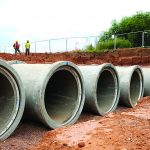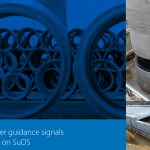
4 January 2022 by admin
A recent revision of precast drainage standard, BS 5911, offers more certainty about the intended working life of precast concrete SuDS solution.
BSI has published a revised edition of BS 5911-1, specification standard for unreinforced and reinforced concrete pipes, with a number of amendments which will improve how specifiers understand the durability of precast drainage systems, including precast SuDS components.
Durability is one of the main characteristics considered in the design of stormwater storage and attenuation tanks and other SuDS systems. There is no single agreed service life period for SuDS infrastructure. But SuDS solutions would be expected to perform effectively and with robust structural integrity throughout the life of the housing estate, retail or commercial development it serves. CIRIA’s Benefits of SuDS Tool (BeST) suggests a 100 years’ service life for a SuDS scheme. Many industry specifications, such as highway standards and PAS 2080, target a minimum design life of 120 years for infrastructure assets.
Defra’s SuDS Non-Statutory Technical Standards require SuDS solutions to be structurally robust throughout the design life of the development. For attenuation tanks, structural design requirements, and its associated working life, are specified in a number of ways: For example, Box culverts are designed to Eurocodes (EN 1992) with a clear reference to an intended working life of 100 years. Geocellular tanks are designed to CIRIA’s C737, but its design life advice can be found in testing standards EN 17152-1 or in products’ BBA certificates (usually 50 to 60 years). In the past, concrete pipeline products standards did not make any clear reference to a specific intended working life. The 100 years intended working life for concrete pipes was mainly based on reinforcement cover and exposure class design for 100 years as specified in the concrete specification standards and National Highways specification for concrete infrastructures. However, this has now changed following the update to BS 5911:
The new standard introduces a clearer justification explaining the link between specification of a DC-4 exposure class concrete mix to a 100 years’ Intended Working Life for pipes. As noted above, that link already existed in the past as all precast drainage is already specified to standards such as Special Digest 1 “Concrete in Aggressive Grounds” and BS 8500. But following the latest amendment, there is now a direct reference to a 100+ years in the pipes standard. The direct reference to a 100 years’ working life would not only help with asset management and Whole Life cost planning, but also with Design for Circular Economy, carbon footprinting and long-term performance.
The new BS 5911-1: 2021 can be purchased from the BSI website. For any further information on the new standard please contact email@precastdrainage.co.uk

7 April 2021 by admin
As we celebrate one year since the new sewers’ adoption code came into force, we look at the new code’s requirements and identify five main reasons why a precast concrete attenuation tank should be the number one option for most SuDS applications.
The new sewers’ adoption Design & Construction Guide (DCG) came into force in April 2020. What is unique about this new ‘Sewers for Adoption’ guide is that it allows Sustainable Drainage Systems (SuDS), such as ponds, swales and underground stormwater attenuation tanks, to be adopted by water authorities in England.
There is a very wide range of underground attenuation tank systems available. It is important to understand that not all these systems meet the strict requirements of adoption under the DCG. In this article, we explore a number of these requirements. We also look at other factors usually considered by Water Companies and other asset owners. We identify five main reasons why a precast concrete attenuation tank is likely to be the safe, appropriate option for most SuDS applications.
1. Access for inspection & cleaning
Clause 3, of C7.8 in the new DCG code, requires tanks to have provisions for access for inspection and cleaning. More crucially, the DCG states that this should also include means of removing any sediment and preventing it from being washed downstream.
The UK has an average rainfall of 1,254mm per annum, and has an increased threat of flooding and persistent rain in the next few decades due to climate change. Despite silt traps, significant amount of sediment and debris enter attenuation tanks every year. The process of removing and retrieving that sediment from inside tanks could be a major challenge for some attenuation tank systems. Despite the fact that some geocellular systems are accessible via CCTV and remote-controlled maintenance equipment, it is not clear how sediment trapped inside such systems can be effectively collected and retrieved without being washed downstream. Only piped systems and modular attenuation tanks can offer sufficient access for maintenance and removal of sediment.
Some plastic pipe systems can be used for attenuation and offer man-entry for maintenance. But the ability of such systems to take sufficient water jetting pressure during cleaning remains uncertain. Within piped attenuation tank systems, only concrete pipeline systems can offer effective water jetting resistance (≥ 4,000 psi) sufficient to remove hardened sediment, grease and FOG.
2. Structural integrity and reliability
attenuation tanks are expected to be installed under fields, car parks and minor roads where a wide range of loads would be presumed. The strength of a tank and its ability to maintain structural integrity over its lifetime is key for its use. Concrete attenuation tanks made of modular precast units, box culvert units and concrete pipes have a long track record and proven performance over their expected design life. The units are designed to Eurocodes and BS 9295, and would account for lateral forces, such as acceleration and braking forces, where applicable.
Lightweight alternatives, such as geocellular tank, may not have such proven track record. Unless strictly designed to C737, the long-term performance of such units against a wide range of loads is yet to be understood fully. Decades after the installation of an underground concrete attenuation tank, articulated trucks can brake over that tank multiple times without any fear of collapse. It is not clear if a decades’ old lightweight tank can offer the same guarantees.
3. Life Expectancy
The expectation within the industry is for any infrastructure to last and function for 100-120 years. This is the life expectancy used in Susdrain’s B£ST tool to assess the sustainability and functionality of SuDS projects. It is a life expectancy that most lightweight attenuation systems, including geocellular tanks, do not meet. The main European standard for geocellular tanks, EN 17152-1, suggests a design life of 50 years. Some plastic pipeline standards, such as EN 13598, offer testing to fulfil a service life of 50 years or more. For concrete attenuation tanks made of modular units, box culverts or concrete pipes, Series 1700 of the Specification for Highway Works in England (NG 1704) suggests that such products are deemed as highway structures capable of fulfilling a design life of 120 years.
4. Carbon footprint
Despite concrete attenuation tanks being significantly heavier than plastic alternatives, there is a significant difference between both systems on embodied and operational carbon emissions. Most geocellular tank systems are made of mould injected polypropylene, which has a cradle-to-grave carbon footprint 30-40 times higher than an equivalent mass of precast drainage products. This massive difference is likely to double if a 100+ years SuDS development service life is considered. The end-of-life impacts of a precast concrete attenuation tank are also likely to be lower. A precast concrete tank can be dismantled and reused after the end of life. Even if demolished after the end of its service, the crushed concrete will absorb significant amounts of carbon dioxide and will be used as aggregates. On the other hand, a geocellular tank retrieved after 50 or 60 years will need to be recycled or incinerated, leading to further emissions which may exceed 900 kg CO2/t and 1340 kg CO2/t respectively. Leaving the plastic tanks underground after use will cause the plastic to decompose over hundreds of years, leading to further Greenhouse gas emissions.
5. Space constraints
Not all sites in need of SuDS can afford sufficient space for ponds or wetlands. Underground tanks are likely to be used in most existing urban sites as tanks can be built under estate roads and car parks. Precast concrete tanks offer a superior option in terms of space constraints as units can be installed in the tightest of places adjacent to existing structures without any concerns over structural integrity. Concrete attenuation tanks can also be installed with lower cover depths and can be installed much deeper compared to geocellular tank alternatives.
SuDS is still a relatively new concept. There have been lots of high-profile applications for almost all attenuation tank systems, but only time can tell whether these applications are successful and offer the asset owners value for money. As the use of attenuation tanks grows over the next few years, it will be possible for the industry to learn more about the strengths and flaws of each attenuation tank solution.

7 April 2021 by admin
As the world continues to be gripped by the unprecedented Covid-19 pandemic, there has been very little coverage of the historic change to the codes governing the adoption of sewers by water authorities. One year ago, the new Design & Construction Guide (DCG) code, previously known as Sewers for Adoption, came into force. The new code introduced significant changes to the principles around sewers’ adoption, as for the first time a number of Sustainable Drainage Systems (SuDS) became adoptable by water authorities.
Adoption has been a major obstacle to the wide introduction of SuDS in England for several years. The new code comes after water companies decided to take the initiative on SuDS responsibility in the absence of any plans by Government. Water UK noted that laws dating back to the Victorian era were used to reinterpret the meaning of ‘sewers’ and include a range of SuDS solutions into the new adoption code. For the first time, a wide range of natural SuDS, such as swales, retention basins and wetlands, became adoptable by water authorities. Engineered SuDS, such as soakaways and underground attenuation tanks, can also be adopted by water authorities.
However, it is important to note that not all SuDS solutions are adoptable under the new code. The Water UK document suggests that adoptable SuDS would only include assets that “convey and return stormwater flows to sewers, surface water bodies or groundwater”. Adoptable SuDS need to have an effective point of discharge. The Code also sets a range of requirements on different SuDS solutions such as attenuation tanks. For example, a tank will need to have provisions for access for inspection and cleaning with means to remove and retrieve trapped sediment in the tank. It is likely that such requirement will significantly limit the field of attenuation tank solutions available for adoption as a significant proportion of geocellular tanks in the UK market may not have provisions to enable sediment trapped inside tanks to be collected and removed without being washed downstream.
The code also refers to standards such as C737, on structural design of geocellular tanks, which requires such systems to be designed with its long-term compressive strength (usually significantly lower than short-term) taken into account. Other structural issues associated with lateral forces on underground tanks, such as vehicles’ braking and acceleration forces, may further limit the options for attenuation systems to be adopted by water companies.
Other aspects, such as tanks’ life expectancy, embodied carbon, and cost of maintenance may all affect the choice of what attenuation tanks to construct and adopt.
More information on sewers adoption can be found at Water UK’s website (here). A good source of information on SuDS include Susdrain (www.susdrain.org) and our new precast concrete SuDS solutions website (www.precastsuds.co.uk).
MPA Precast
The Old Rectory, Main Street
Glenfield, Leicestershire. LE3 8DG
info@precastsuds.co.uk
+44 (0) 116 232 5170

Recent Comments